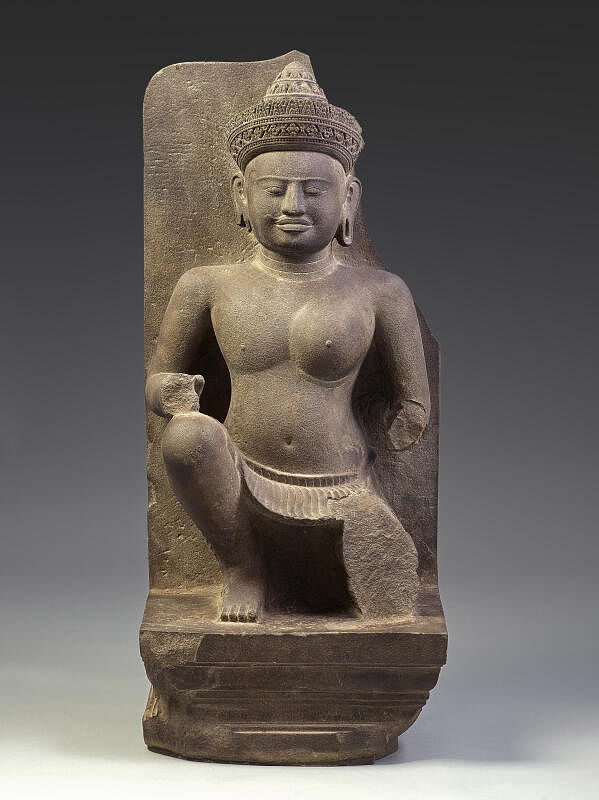NEW YORK (NYTIMES) - Nawapan Kriangsak found out as a young girl that running in her father's apartment was forbidden.
Her father, Mr Douglas Latchford, was perhaps the world's leading collector of Cambodian antiquities and every corner of his apartment in Bangkok featured a statue of a Khmer deity too valuable to risk to horseplay.
When she went to bed as a child, Kriangsak said in an interview, the brooding stone faces would haunt her. "Daddy," she would tell him, "they walk at night."
Last summer, when her father died at 88, they all became hers - 125 works that make up what is said to be the greatest private collection of artefacts from Cambodia's 1,000-year-old Khmer Dynasty.
But Kriangsak also inherited a disquieting legacy. Mr Latchford was not only a recognised scholar of Khmer antiquity, he was also someone who had been accused of having trafficked for decades in looted artefacts.
Kriangsak said the collection, valued by some at more than US$50 million (S$66 million), loomed as an enormous burden to curate and maintain. So in a gesture that Cambodian officials embrace as supremely generous, she decided to return all of her father's Khmer objects to that country, where they can be studied by Khmer scholars and shown in a new museum to be built in Phnom Penh.
It is a stunning turn of events for Cambodians who saw so many of their country's ancient artefacts disappear during the reign of Pol Pot and the surrounding years of civil war.
Officials say the objects had been revered for generations and never perceived as sources of wealth or profit. "Happiness is not enough to sum up my emotions," said Cambodia's minister of culture and fine arts, Ms Phoeurng Sackona.
"It's a magical feeling to know they are coming back. These are not just rocks and mud and metal," she said. "They are the very blood and sweat and earth of our very nation that was torn away. It is as if we lost someone to war and never thought they'd come home, and we are suddenly seeing them turn up at our door."
Kriangsak, 49, a lawyer, prefers not to discuss the accusations aimed at her father, but it is clear she views his collecting as acts of veneration, not greed.
"Despite what people say or accuse against Douglas, my father started his collection in a very different era, and his world has changed," she said.
"I have to see the world from the point of view of my family today. I would like everything that Douglas assembled be kept where people around the world can enjoy it and understand it. There is no better place than Cambodia, where the people revere these objects not just for their art or history, but for their religious significance."
So far, 25 major works dating as far back as the 10th century have been shipped to Phnom Penh from Bangkok. Another 100 or so objects will be sent to Cambodia in the coming months, both from Bangkok and from Mr Latchford's second home in London.
Lawyers for Kriangsak and the Cambodian government put the value of the collection at more than US$50 million if sold individually. Many of the objects are one of a kind, and there are also jewels and golden crowns that were used to adorn the sculptures as they stood in their sacred alcoves.
Cambodian officials said the newly donated items would be carried at the museum as "The Latchford Collection".

Mr Latchford also made gifts to many United States museums, including the Metropolitan Museum of Art in New York, which in 2012 returned two massive items, known as the "Kneeling Attendants", to Cambodia after determining they had been looted.
Mr Latchford had donated parts of the statues, which had been broken, to the museum, though he was never accused of any wrongdoing. But events like that helped to buttress concerns that his collecting methods during the years of Cambodia's civil war (approximately 1965 to 1979) were dubious.
In 2019, federal prosecutors in New York charged him with trafficking in looted Cambodian relics and falsifying documents, and they said he had "built a career out of the smuggling and illicit sale of priceless Cambodian antiquities, often straight from archaeological sites".
He long rejected such allegations, often insisting he was the saviour of treasures that would have otherwise been destroyed or left to moulder in the jungle.
Federal prosecution efforts against Mr Latchford, who was never extradited, ended with his death in August last year.

